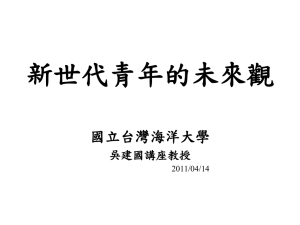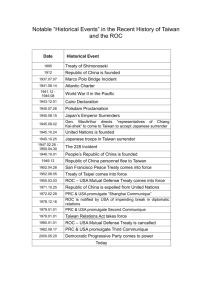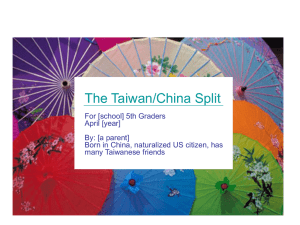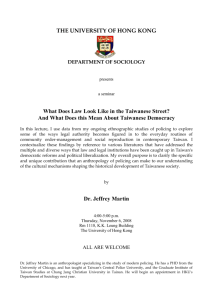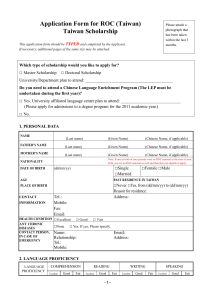Sino-Taiwan Relations (1949-1979)
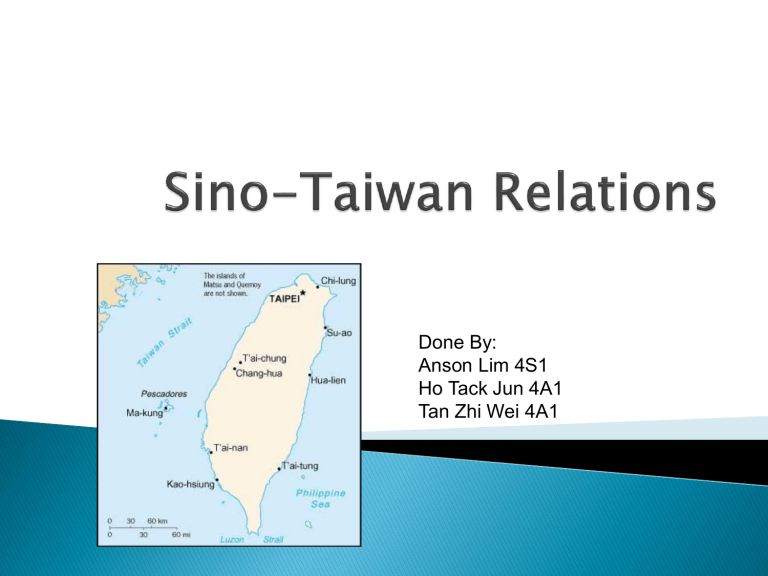
Done By:
Anson Lim 4S1
Ho Tack Jun 4A1
Tan Zhi Wei 4A1
Brief History
Sino-Taiwan relations during Cold War
Sino-Taiwan relations after Cold War
Taiwan was initially an island, under the governance of the Qing government
However, after the Sino-Japan War in 1895,
Taiwan was ceded to Japan
Japan then ruled Taiwan until 1945. After its defeat, Taiwan was then ceded back to the
Republic of China (ROC), which was governed by Chiang Kai Shek’s KMT government.
•
•
•
•
The KMT and the Communist Party of China (CPC) were originally in conflict until the Xi’an incident in 1936, in which both parties agreed to cooperate to fight the Japanese
The KMT and the CPC then fought a war following the end of World War II for control over the sovereignty of China : Split over ideology
In 1949, the civil war turned in the Communist’s favour, and the capitalist KMT government retreated to Taiwan
The Communists gained control of the mainland while the KMT has stayed at Taiwan ever since
•
•
•
•
The two sides were technically still on confrontation during this period
The ROC repeatedly halted advance of the troops from the People’s Republic of China (PRC), ruled by the Communists, towards Taiwan, such as in
Kinmen in 1950
Some 12,000 KMT troops had escaped to Burma
(Now Myanmar) after the civil war
While initially US supported attacks by these troops against the PRC, after Burma appealed to the UN, 6,000 of these troops left Burma and the disbandment of the army was declared
During the Korean War, some of the captured
Communist Chinese soldiers, some of whom originally fought for the KMT, were repatriated to Taiwan
Throughout the 50s, there were insurgencies in China resisting the Communist government, as well as routine air strikes by the ROC government on mainland China
The PRC government also routinely shelled islands in Taiwanese possession
•
•
•
The US government recognized the ROC as the sole legitimate government of China in
1950
While US reiterated that it would not be involved in any attack on Taiwan, this changed after the Korean War
Upon seeing the Communist’s ambition to conquer independent states in Asia through armed invasion and war, it was decided that it would be the US’s strategic interests in the
Pacific to protect Taiwan
A naval fleet was sent to the Taiwan Strait to protect Taiwan against aggression from the
PRC
The ROC government was also to stop all attacks on the mainland
In 1953,however, the blockade by the US fleet was lifted
The KMT placed troops on islands in between mainland China and Taiwan
The ROC began building defensive structures
The People’s Liberation Army(PLA) of the
Communists then began to shell these islands under KMT possession in 1954
There was fear of Communist expansion as
PRC shelled islands along the Taiwan strait
As the ROC was part of US’s defensive strategy along the Pacific from South Korea to
South East Asia
Both the ROC and the US then agreed to a mutual defensive agreement, which did not cover these islands
•
•
•
Congress passed the Formosa Resolution in
January 1955 authorizing the US president to use armed forces to defend ROC possessions against armed attack
The PRC government indicated it was willing to negotiate in April 1955 and ended the conflict on 1 May 1955
However, the fundamental problems between both countries, in ideology and governance, remain unresolved
This began in Aug 1958 and ended 3 months later, with military engagements between the
ROC and PRC
Islands along the Taiwan Straits was again bombarded
While US resisted the KMT’s requests to bombard mainland artillery batteries, it provided Taiwan with arms and weapons
•
•
•
The PRC then announced an even-day ceasefire, in which the islands will only be shelled on odd-numbered days
Both sides never signed any agreement or treaty to officially end the war
Bombardment from both sides then started to take on a symbolic meaning, with artillery bombardment on and off
•
•
In later years, propaganda sheets were fired instead of live shells
The bombardment ended in 1979, following
US and China establishing diplomatic relations
•
•
•
Until 1971, most countries recognized the
ROC as the legitimate government
NATO countries (i.e. anti-communist) recognized the ROC while Soviet Bloc countries and members of the non-aligned movement recognized the PRC
Propaganda permeated into the education system on both sides, each labeling the other as bandits and living in misery
•
•
In 1978, the ROC government allowed visits to mainland China, benefitting many, especially former KMT soldiers, whose families were on the other side of the strait
In 1979, as the US regained normal diplomatic ties with the PRC, it had to recognize the principle of ‘One China’ and hence broke off diplomatic relations officially with Taiwan, whom it had recognized as the legitimate government, resulting in a thaw in relationship cross-strait
•
•
•
•
The Cold War, being an ideological conflict between the USSR and USA, both of which had different political systems, also manifested in the conflict between the ROC and PRC
The ROC was communist while the PRC was capitalist
Therefore, it became a source of conflict, especially when both parties needed to form a new government in China after the Japanese surrender
This led to both sides, trying to triumph over the other party, through military aggression, similar to that between USSR and USA over control of the world, which resulted in incidents such as the Cuban missile crisis and Bay of Pigs invasion
•
•
•
While Chinese-Soviet relations broke down after the
Korean War, US was still worried about communist expansion and try to contain it so that it does not reach its sphere of influence in the Pacific, resulting in its continual support for the ROC, even after US and the PRC government established diplomatic ties
If Taiwan was to fall, other countries such as Japan and the Philippines nearby could also fall, as communism would rampage through Asia like dominoes
This, however, led to prolonged conflict between both parties as well once superpowers got into play, which disrupted the balance of power between the PRC and
ROC
In 1971, the ROC government walked out of the
United Nations shortly before it recognized the PRC government in Beijing as the legitimate holder of
China's seat in the United Nations. The ROC had been offered dual representation, but Chiang Kai-shek demanded to retain a seat on the UN Security Council, which was not acceptable to the PRC. Chiang expressed his decision in his famous "the sky is not big enough for two suns" speech.
In October 1971, Resolution 2758 was passed by the
UN General Assembly and "the representatives of
Chiang Kai-shek" were expelled from the UN and replaced as "China" by the PRC. In 1979, the United
States switched recognition from Taipei to Beijing, following the “One China” Principle.
Background
US President Nixon and his National Security Adviser,
Henry Kissinger, viewed opening relations with China as a part of the strategy for withdrawing the United
States from the Vietnam War. They also saw the relationship as a strategic advantage in the Cold War against the Soviet Union. In China, Mao Zedong and his advisers were equally interested in achieving balance in their foreign relations as they felt that the
Soviet Union was a threatening “hegemonist” and
“revisionist” practicer of “social imperialism.”
As the relationship between the PRC and the United
States deepened in the years after 1972, the two sides made progress toward the establishment of full diplomatic relations. To establish full relations required that the United States withdraw its troops from the island of Taiwan and withdraw diplomatic recognition of the government of the Republic of
China (ROC) on Taiwan. These conditions were fulfilled under U.S. President Jimmy Carter, and an agreement on mutual recognition was issued on
December 15, 1978.
However, the Democratic Carter administration’s recognition of the PRC did not go down well in the
Republican-controlled Congress. Indeed, many members of Congress would have much preferred not to extend diplomatic recognition to a Communist power. As a result, Congress passed the “Taiwan
Relations Act” of 1979 in order to lay the basis for a continuing relationship with Taiwan.
The PRC viewed the Taiwan Relations Act as "an unwarranted intrusion by the United States into the internal affairs of China.” The Three Joint
Communiques (a collection of three joint statements made by the US and PRC that played a crucial role in building relations between the two countries) were signed in 1972, 1979, and 1982. The United States declared that the United States would not formally recognize PRC’s sovereignty over Taiwan as part of the Six Assurances (guidelines used in relations between US and Taiwan regarding the sale of arms to
Taiwan) offered to Taipei in 1982.
Chiang Kai-shek was succeeded by his son Chiang Chingkuo, liberalizing the system when in power. In 1986, the
Democratic Progressive Party was formed to counter the
KMT as the KMT was becoming increasingly unpopular with the Taiwanese. This organization was formed illegally, and inaugurated as the first party in opposition to Taiwan.
Martial law was lifted one year later by Chiang Ching-kuo, emergency rule which had existed ever since Chiang’s forces originally occupied Taiwan. Chiang selected Lee
Teng-hui, a Taiwanese born technocrat to be his Vice
President. The move followed other reforms giving more power to Taiwanese born citizens and calmed anti-KMT sentiments during a period in which many other Asian autocracies were being shaken by People Power movements.
Chiang Ching-kuo died in 1988. Chiang's successor,
President Lee Teng-hui, continued to hand more government authority over to Taiwanese born citizens. He also began to democratize the government. Taiwan underwent a process of localization, under Lee. In this localization process, local culture and history was promoted over a pan-
China viewpoint.
In the first full election in many decades, the governing Kuomintang in Dec. 1991 won 71% of the vote, affirming the island's opposition to reunification with China. In Feb. 1993 the president, himself a native Taiwanese, nominated Lien Chan, another native, to be prime minister, marking a further generational shift away from the mainland exiles. In the island's first free presidential election in 1996, voters defied mainland intimidation and gave 54% of the vote to incumbent president Lee Teng-hui.
The 1996 election prompted the PRC to conduct a series of missile tests in the Taiwan Strait to intimidate the Taiwanese electorate so that electorates would vote for other pro-unification candidates, Chen Li-an and Lin Yang-kang. The aggressive tactic prompted U.S. President Clinton to invoke the Taiwan Relations Act (1979) and dispatch two aircraft carrier battle groups into the region off
Taiwan's southern coast to monitor the situation, and
PRC's missile tests were forced to end earlier than planned. This incident is known as the 1996 Taiwan
Straits Crisis.
In 1998, Taiwan renewed its push for a separate UN seat—its sixth attempt in recent years. The move has been blocked each time by the Beijing government.
President Lee Teng-hui angered mainland China by announcing in July 1999 that he was abandoning the long-standing “One China” policy that had kept the peace between the small island and its powerful neighbor and that he would from then on deal with
China on a “state-to-state basis.” China which had vowed to someday unite Taiwan with the mainland, retaliated by conducting submarine warfare exercises and missile tests near the island in an effort to intimidate its neighbor, as it had once before in
1996. One of Lee's final acts as president was to declare on German radio that the ROC and the PRC have a special state to state relationship.
Lee's statement was met with the PRC's
People's Army conducting military drills in
Fujian and a frightening island-wide blackout in Taiwan, causing many to fear an attack.
The impact of the Cold war is still evident even as the PRC and ROC, communist and capitalist respectively, conduct relations under uneasy circumstances. The PRC viewed that
Taiwan belonged under China and would not allow Taiwan’s independence with a democratic government. However the capitalist KMT does not agree with the communists and this led to separation and the formation of two Chinese states under leaders with differing ideologies. Although the USA had to break off relations with Taiwan so as to gain support from
China, which would help the USA triumph over USSR in the
Cold War, the USA did not want Taiwan to fall to communism hence established the Taiwan Relations Act in 1979. The conflicting ideologies present in the Sino-Taiwan relationship showed the extent of the Cold War influence on other countries.
http://en.wikipedia.org/wiki/Cross-Strait_relations http://www.cfr.org/china/china-taiwan-relations/p9223 http://images.google.com/imgres?q=Taiwan+island&hl=en& biw=1024&bih=636&gbv=2&tbm=isch&tbnid=_gx3-
FqS8s4gqM:&imgrefurl=http://english.cri.cn/2238/2005-3-
23/45%2540219759.htm&docid=ER7NEocgrgT0KM&w=330& h=354&ei=AqpLTr6EGYiurAevz8H2DQ&zoom=1&iact=hc&vp x=762&vpy=117&dur=561&hovh=233&hovw=217&tx=73&t y=146&page=1&tbnh=147&tbnw=137&start=0&ndsp=16&v ed=1t:429,r:5,s:0 http://flagspot.net/images/c/cn%7Dcpc.gif
http://www.ussskagit.org/shippix/haring1.jpg
http://www.nashville247.tv/files/nixon-in-china.png
http://4.bp.blogspot.com/_iVsdq1mJCCI/RyShlUtEFxI/AAAAA
AAAAag/mWi5STYJqn0/s320/1416-001M.jpg
http://en.wikipedia.org/wiki/Three_Communi ques http://en.wikipedia.org/wiki/Six_Assurances http://en.wikipedia.org/wiki/Taiwan_Relation s_Act#Reactions http://afe.easia.columbia.edu/ps/china/taiwa n_relations_act.pdf
